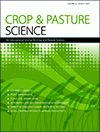This paper emphasises the laboratory- and field-based methods of salinity screening for rice cultivar that can broadly divided into three categories: (1) morphological or phenotypic parameters; (2) physiological and biochemical parameters; and (3) molecular marker analysis. We introduce the laboratory-based IC50 method as another approach for screening salt toxicity to determine the degree of the salt tolerance for rice cultivars.

Crop and Pasture Science
Volume 72 Number 2 2021
Accurate assessment of a crop’s progress through the phases of development relies on objective, quantitative methodology. Progress through kernel development in wheat and barley, and the timing of physiological and harvest maturity, can be assessed through spike moisture content. A field experiment utilising 10 diverse cultivars sown over six dates determined that spike moisture content at physiological maturity was 43% for wheat and 50% for barley.
CP20326Application of 50K chip-based genetic map to QTL mapping of stem-related traits in wheat

Stem-related traits play an important role in the lodging resistance of wheat. In this study, 198 recombinant inbred lines were used to detect stem-related traits in wheat by mapping quantitative trait loci (QTLs), and two stable QTL clusters were identified. The reported findings can provide references for elucidating the genetic mechanism of stem-related traits.
CP20380Grain mineral composition of Argentinean-adapted wheat cultivars: a case study

Improvement of the nutritional quality of cereals through selection is hampered, in part, by limited variation in modern cultivars and the strong environmental effect. In this work, we characterised the mineral profile of grains in a set of 35 Argentinean-adapted wheat cultivars. The genotypic variation found could be used in breeding programs aimed at improving wheat grain quality.
CP20434Identification and expression characterisation of SbERECTA family genes in Sorghum bicolor
The SbERECTA (SbERs) gene family has two members, SbER10 with three copies (SbER10_X1, SbER10_X2, and SbER10_X3) and SbER4 with two copies (SbER4_X1 and SbER4_X2), in the sorghum genome. The promoter of the SbER family contains ABA, low temperature, anaerobic induction and other core elements, and SbER10 genes actively respond to hormone induction. SbER10_X1 expression was significantly and positively correlated with plant biomass among 32 sorghum germplasm resources.
CP20434 Abstract | CP20434 Full Text | CP20434PDF (1.7 MB) | CP20434Supplementary Material (1.6 MB) Open Access Article
In addition to yield, seed quality is an important driver of farmer profitability. Our survey showed a revenue loss of 23% of gross value of production for chickpea farmers solely from grain quality penalties. In addition, some ‘seed markings’ were misclassified as ‘mould’, which has a lower threshold and harsher price penalties. Improvements in grain classification globally are needed to ensure that farmers are appropriately rewarded for good quality, remain financially viable, and continue to feed the expanding global population.
Quantifying inoculum levels of Verticillium dahliae in field soil is essential for understanding potential disease pressure of Verticillium wilt in cotton and making informed management decisions. From results of this study, a soil sampling protocol has been developed for quantifying V. dahliae inoculum in Australian cotton soils that includes sampling soil at 2–24 cm depth before planting and using a direct-plating method with dry soil on Sorenson’s NP-10 media.
CP20299A root aphid Aploneura lentisci is affected by Epichloë endophyte strain and impacts perennial ryegrass growth in the field
 , David. E. Hume
, David. E. Hume  , Wade J. Mace
, Wade J. Mace  , Marty J. Faville
, Marty J. Faville  , Sarah C. Finch
, Sarah C. Finch  and Vanessa Cave
and Vanessa Cave
An aphid, Aploneura lentisci, that feeds on grass roots is widespread in pastures in New Zealand and Australia. This paper reports data confirming that perennial ryegrass infected with a strain of Epichloë fungal endophyte, AR37, is highly resistant to this aphid and shows that another endophyte strain, AR5, gives the same level of control. Suppression of high aphid populations by these endophytes in the field at Ballarat resulted in a 37% increase in pasture production over endophyte-free ryegrass over a 5-month period.



